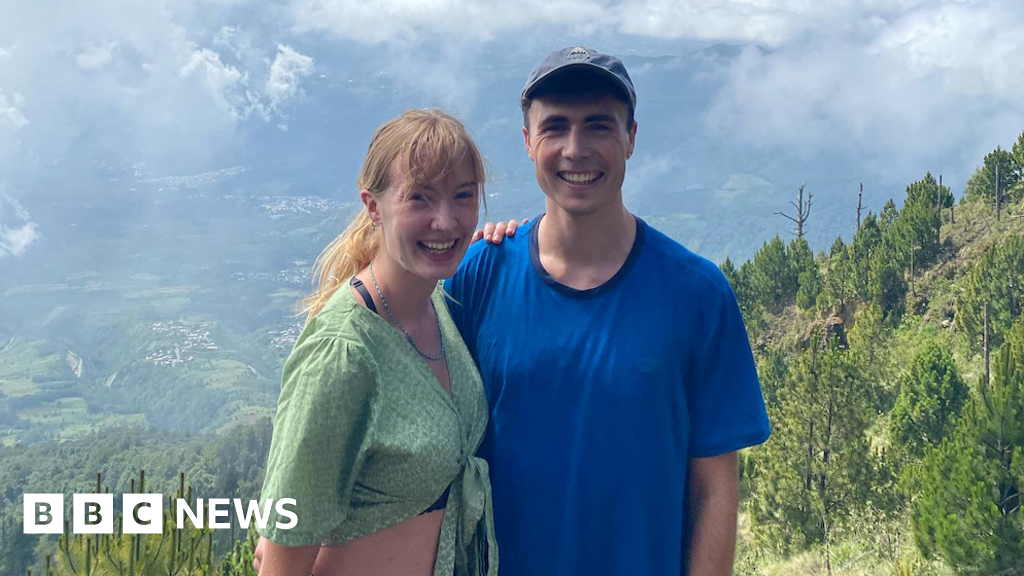By Freya Scott-Turner, BBC News
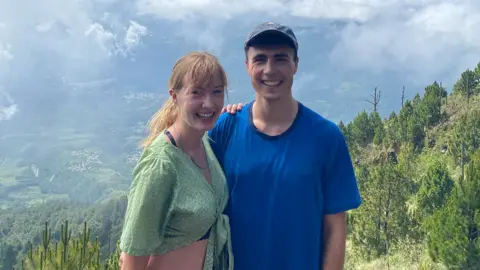 Leila Mitchell
Leila MitchellAt one of Central America’s most popular tourist spots, you can stand a few hundred metres from boiling volcanic lava.
Meet any backpacker in a hostel bar in Central America, there is a high chance they have hiked, or are planning to hike, the twin volcanoes of Acatenango and Fuego.
“The thing I remember most is the sound of the bubbling,” recalls 23-year-old Leila Mitchell, who visited in 2022. “Huge spurts of orange, glowing lava. It was breath-taking.”
Recent increased volcanic activity has sent the popularity of the tours skyrocketing – but it’s also made them more dangerous.
“It’s only a matter of time before someone gets killed,” says Matthew Watson, Professor of Volcanoes and Climate at the University of Bristol.
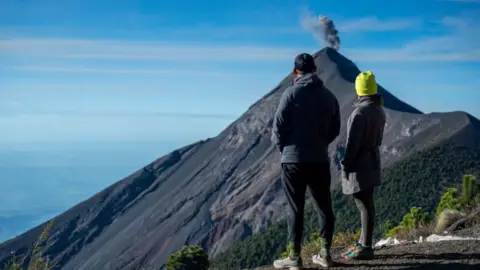 Getty Images
Getty ImagesThe twin volcanoes sit on the outskirts of Antigua, a city in the central highlands of Guatemala.
Climbing them is considered a rite of passage for travellers visiting the country, and it is Fuego in particular that they come to see as this active volcano can erupt 200 times a day.
Capitalising on this feat of nature are the numerous tour companies which take groups perilously close to Fuego’s simmering crater. Some are known to go within 100 metres of its rim.
 Getty Images
Getty ImagesProf Watson used to take students on a yearly field trip to Fuego – but stopped in 2015 after it became more energetic. “An INSIVUMEH volcanologist advised against going up there, and we’ve not been up since,” he says.
INSIVUMEH is a government agency that monitors Fuego. Since 1999, it has recorded 79 serious eruptions – called paroxysms – with more than 47 occurring after 2015.
Six years ago, this ratcheting up of activity had tragic consequences.
On 3 June 2018, a powerful eruption caught much of the surrounding area by surprise. It buried the entire town of San Miguel Los Lotes under ash and rock.
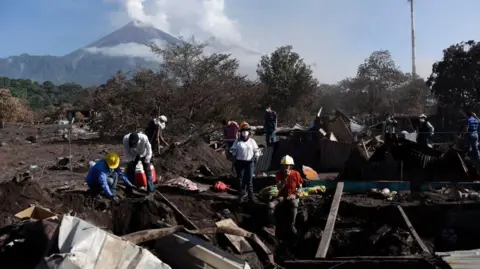 Getty Images
Getty ImagesJonathan Dovgan Prera was on his way back to Acatenango from Fuego that day with a tour group he was guiding.
“I remember hearing the tremors. An older guide said something bad was about to happen… ‘just run’.”
His tour group that day was made up of university athletes, who managed to sprint back to base camp unscathed. “You could feel the ash and small rocks hitting you,” he recalls. “That was one of the scariest moments of my life.”
The official death toll from the eruption was 218 people, but locals say as many as 3,500 people disappeared that day.
Prof Watson says out-of-date census data explains this discrepancy, as well as the difficulty in identifying remains.
Despite his near-death experience, Jonathan has continued to climb Fuego and leads two to three tour groups a week up the active volcano.
“Explosive activity continues to happen daily, virtually uninterrupted” says Roberto Mérida, a volcanologist at INSIVUMEH. “It is precisely what attracts the attention of tourists.”
Yet many are completely unaware of the risks associated with this much-touted tourist experience.
Leila’s boyfriend Louis Martlew, 23, visited the volcanoes with her. “We signed a piece of paper and laughed about the fact that we were signing our life away.”
It was only after they returned that another traveller told them about the 2018 eruption. “I was stupid not to realise how bad that could have been,” Leila said.
“Because it’s made for tourists and it’s just a thing that happens, I thought it was perfectly safe.”
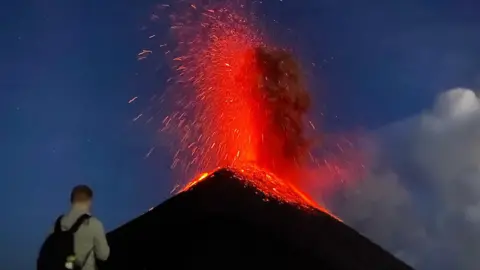 Louis Martlew
Louis MartlewSix years on, the hike is more popular than ever.
Local guides estimate that 200 to 400 people visit the volcanoes every day, jumping to as many as 1,000 on a busy Friday or Saturday.
Matt Hartell was one of the first adventure tour guides to set up shop in the area in 1998. “We’d be the only people on the mountain,” he remembers. “Now there are 30 other companies out there every day of the week.”
Tourism is a huge economic driver for Antigua in particular and Guatemala in general. In 2018, the tourism industry brought over £838 million to the Central American nation’s coffers.
And it is those who derive their livelihoods from guiding groups up the volcanoes that are the most at risk as they spend far more time in the danger zone than most others.
“Some of my guides don’t want to take people over there” says Matt Hartell, adding that he himself tries to avoid going “whenever I can”.
So, is there an alternative?
The terraces of Acatenango, Fuego’s dormant twin, offer a spectacular view of Fuego’s lava shows.
All tours hike Acatenango first, resting in a base camp there. Those who are feeling adventurous then continue on to Fuego.
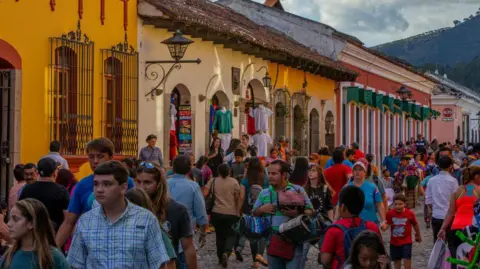 Getty Images
Getty ImagesProf Watson is baffled that tour groups continue to go the active volcano. “Given how good the observation platform from the terraces [of Acatenango] is, it seems a completely unnecessary risk.”
INSIVUMEH issues daily bulletins in Spanish on Facebook, X and its website warning of risks of injury or death to those who go too close to Fuego’s crater.
But as climbing Fuego is not illegal, INSIVUMEH can only warn of the risks and lacks the power to stop visitors from going there.
On the ground, it is not obvious who is in charge. Local municipalities charge entry fees for various portions of each volcano and the surrounding area.
Guide Matt says volcano tourism is “a cash cow” for local authorities and that the central government “just isn’t strong enough” to impose any restriction.
INSIVUMEH volcanologist Roberto Mérida is pessimistic that anything will change in time to avert disaster.
“Municipalities, tour operators and the tourism institute have prioritised economic exploitation over disaster prevention.”
“Actions are usually [only taken] in response to tragedy,” he adds. “In this case it will be until one or more tourists die in the Fuego volcano.”

In response, the National Tourism Institute of Guatemala (INGUAT) told the BBC it “makes recommendations and suggestions for visits to national and foreign tourists based on information from official sources on risk prevention and in accordance with the regulations of each corresponding National Park, Protected Area or Nature Reserve.”
INGUAT added it does not promote tourism “in places that represent any type of danger” to tourists and that it “does not receive any type of income or benefits from visits to any National Park, Natural Park or volcano.”
The Muncipalities of Acatenango and San Juan Alotenango have been approached for comment.
Some suggest that better communication channels could help.
Dr Ailsa Naismith wrote her doctoral thesis on Fuego. On research trips, she has spoken with many guides who are eager to know more about the volcanoes they have built their careers around. “With the experience we have from researching it, it might seem blatantly obvious that it’s dangerous. But sometimes it’s not,” she says.
When asked if he would like more interaction with volcanologists and monitoring bodies, guide Jonathan Dovgan Prera says he was keen. “It would teach us so much more about what to expect.”
His fellow guide Matt Hartell would like to see formal roundtable conversations held between the groups who regularly visit the volcanoes and those with expertise to offer about managing both tourism and volcano conservation effectively.
But volcanologists think that is not enough.
Roberto Mérida suggests “a restriction zone, whose radius depends on the level of volcanic activity”.
Others just think the risk is too high, and would rather no one went to Fuego at all, instead climbing just Acatenango.
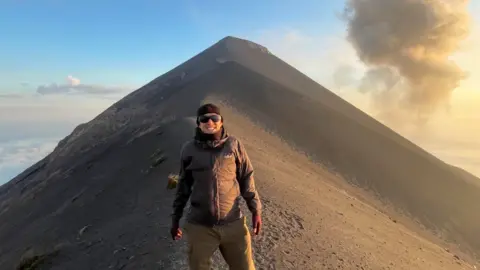 Getty Images
Getty ImagesBut convincing keen adventure travellers is no easy task.
Some, like 24-year-old Alex Gordon, say the experience of being near the simmering crater is unique – and one they are willing to take a risk for.
“The feeling [of being] at the top of the volcano will sit with me forever,” he says.
Leila is less sure. Having climbed both she says the dormant volcano offers stunning views and “would still be a challenging walk up a beautiful landscape”.
Given what she now knows of the dangers, she’d be happy to enjoy the spectacular eruptions of Fuego from a safe distance.

